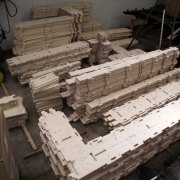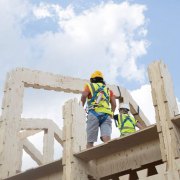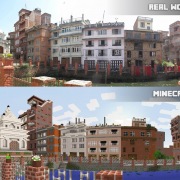˂˂It sounds absolutely logical to think that if the same person plays both roles – the inhabitant and the builder –, no problem would need to be solved. Unfortunately, today’s situation is so absurd… that in practice the direct opposite is true: rarely an architectonic object satisfies the inhabitant, and the builder prevails over him. It seems that our social and economic system has been devised just to multiply the efforts in order to avoid builder and inhabitant to be the same person. ˃˃ 1
Yona Friedman was an architectural theorist who developed his major theories in the 1960s and 1970s, but today his words sound more topical than ever.
He founded the “Mobile Architecture Study Group” (Groupe d’Études d’Architecture Mobile) to promote and support unconventional, non-traditional architecture. Essentially, the philosophy of collective focuses on the following concept: architecture can be altered by the designer as well as by the people who make use of it. An impressive theory with an utopian drift, even though Friedman declared more than once: «I have always tried, in architectural studies, to develop projects that were feasible.» Yona Friedman studied the city, but more specifically its engine, namely the human capital, people who live in it. For this reason, the well-known architect can be regarded as a pioneer of the concept that in the XXI century takes the name of “smart city”.
If we type “smart city” into Google Italy, we read that «In urban planning and architecture, smart city is a set of urban planning strategies aimed at optimizing and innovating public services. The goal is to connect city’s physical infrastructures with the intellectual, social and human capital of its inhabitants thanks to new communication, mobility, environment and energy efficiency technology with the aim of improving life quality and meeting the requirements of citizens, companies and institutions.»2
Citizens – which are the human capital, the inhabitants in architecture – are the focus of the discussion. Friedman saw their potential, and recognized their participation as the core of architecture’s future. In his work “The Architecture of Survival”, Friedman carried out an historical and contextual analysis, realizing that the world was destined for extreme poverty and extinction of technical means. According to the architect, the only way out is (social) equality, which unfolds “an incredible technical ingeniousness“. It sounds like a step back – because of global poverty, humans go back to makeshift solutions and simple materials. But at the same time, they get the chance to rethink the space where they live every day. This sort of global civil backing out turns into an opportunity for citizens to design and create their own living space.
Carlo Ratti senses this imminent change too. Unlike Friedman, he actually regards technology as a supportive element for the participation of citizens, who have to be involved in the design phase, in order to reach a harmonious development and a rebirth of the cities of the future.
In his work Open Source, Ratti pictures a reality where the architect neither is the focus of attention nor has an “object-oriented” responsibility. Online platforms come on the scene to help citizens with no practical knowledge to design and build their own house. WikiHouse, for example, is a free and easy to use 3D design software, which includes various projects created by users. «Everyone can download them, print them with the plywood on a milling machine, and put them together just like an Ikea piece of furniture or a life-size puzzle. The first house prototype took less than 24 hours to be built – cut and assemblage included – at incredibly low costs.» 3
Is this the architecture of the future? Are these technological processes gradually debasing the value of professionals?
The answer is no. It’d be worrying if thousands of years of architectural history were deleted with a click. What is changing is not the profession, but the way of working – architects work no longer by themselves, but together with other people. The project is no longer an end in itself, but it’s part of a chain. According to Habraken, «architects are like gardeners, who learn horticulture, inspect the land, take care of flowerbeds and feed plants… Architects should work together with inhabitants instead of submitting a finished product. They allow the most intimate material element of buildings (houses, offices, etc.) to be an exclusive prerogative of users.» 4
Now more than ever, these platforms are having a great success, giving voice to those who generally do not take decisions about urban planning. Another important example is the American initiative Block by Block. Unlike WikiHouse, which is a project for designing and building just houses, Block by Block – founded in 2015 and based on the computer game Minecraft – gives users the chance to visualize and build public spaces. Thanks to its user-friendly interface, everyone can design, even children and old people. Block by Block has been used in pilot projects in Kenya and Nepal, and afterwards in 100 projects in 30 countries.
Yona Friedman devoted himself to the United Nations and the Unesco, working on manuals about self-build for Africa, South America and India. His mission was proving the feasibility of direct participation of people in design projects. That’s why the Hungarian architect can be considered – together with De Carlo – a precursor in participatory design.
Giancarlo de Carlo’s model of participatory architecture was considered to be vain (especially because of the little interest of citizens), impracticable and utopian, and now utterly anachronistic. Maybe today the world of architecture – together with the way of doing architecture – is radically changing and is including new actors, who are not just architects. Or maybe this digitization phase will just be temporary. It’s a new way of doing architecture where everyone – and not just experts – can play a role and regain possession of everyday spaces. We are facing a participation 2.0 that goes beyond “classic” discipline, which used to transform things in order to adapt them to human use. We are facing an architecture of survival that tries to modify the way humans make use of things.
Translated into English by Giada D’Elia.
¹ Yona Friedman, L’architettura della sopravvivenza, Bollati Boringhieri, Torino, 2009, pp. 16.
² Smart City, wikipedia, www.wikipedia.org, date of consultation 5/09/2019.
³ Carlo Ratti, Architettura Open Source, Torino, Einaudi, 2014, pp.100.
⁴ Carlo Ratti, Architettura Open Source, cit, pp. 116-117.











